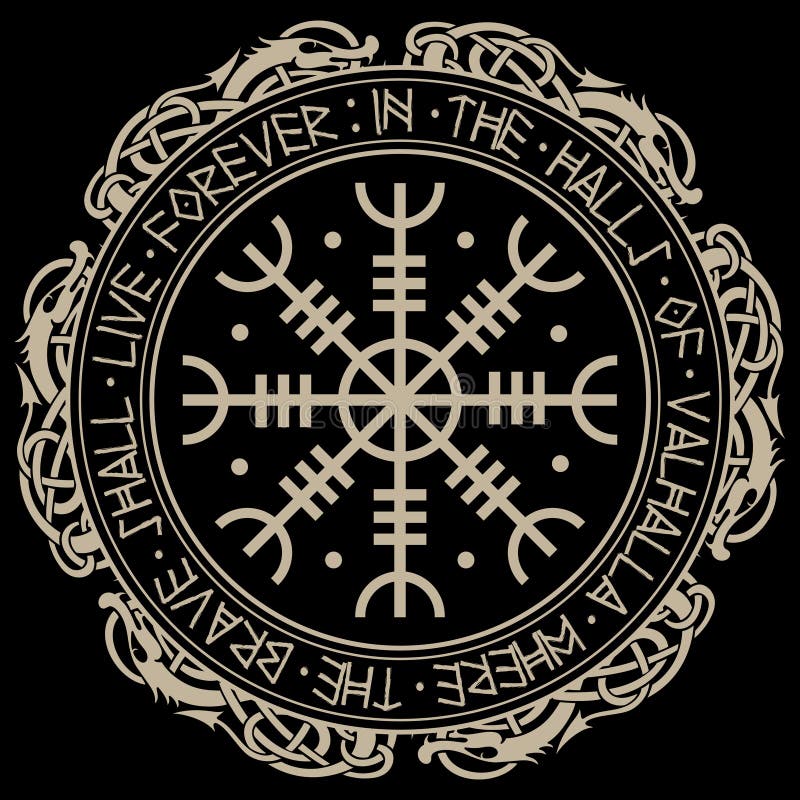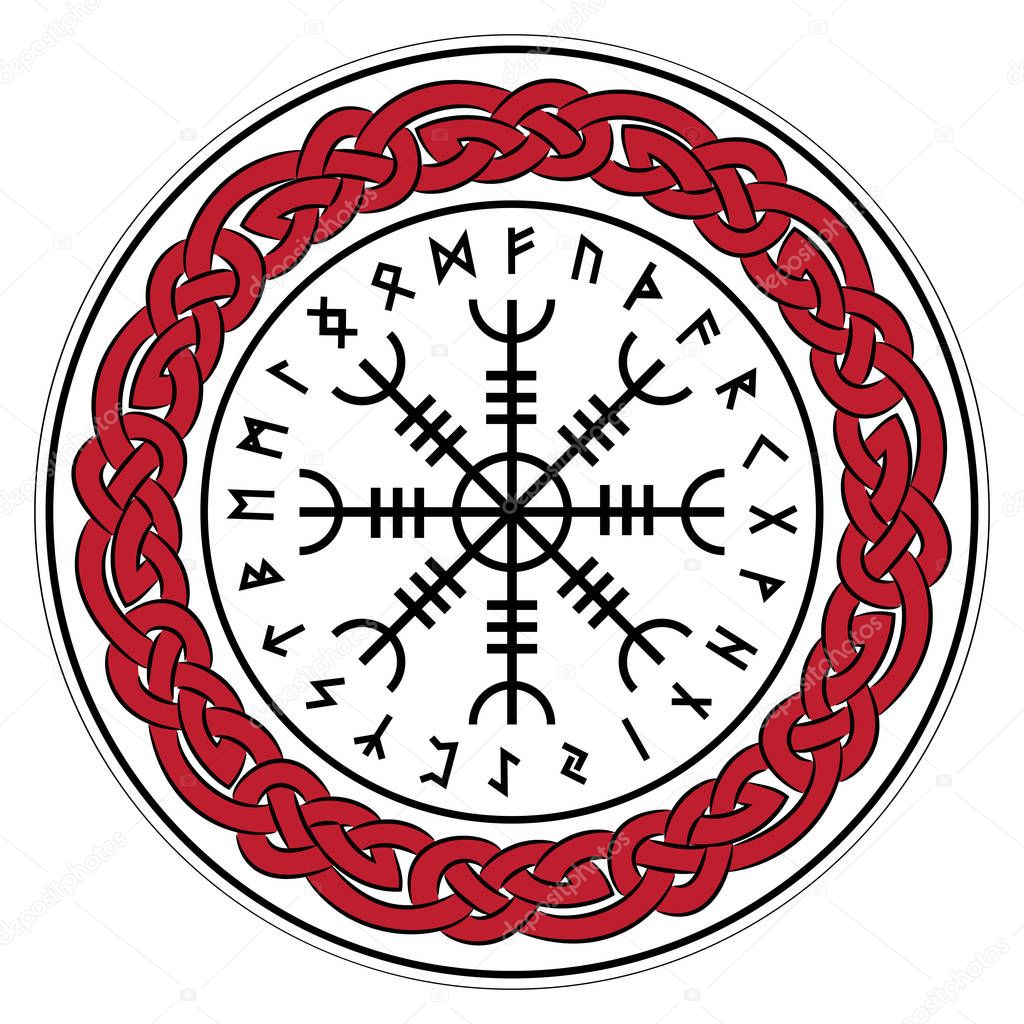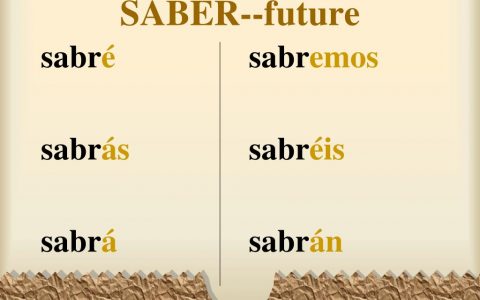The various symbols in Norse mythology are popular. Moreover, runes were a type of symbol and a special choice of Viking communication. However, what comes to your mind when most of us think of the runes we know? For us, the first shape that springs to mind is a snowflake shape with tridents at the ends. Strikingly, this symbol is not a rune though. Hence, this symbol is the Helm of Awe in Norse mythology.

For Vikings, the Helm of Awe (Aegishjalmur) is highly crucial. It was one of the most powerful magical runic symbols that the Vikings used. Moreover, they believed that it provided protection as well as courage and strength to Viking warriors. Thus, if you would like to know more about this Nordic icon, then tune in to our article. Scroll over and keep reading as we shed light on the Helm of Awe, its meaning, history, and much more.
Helm of Awe Symbol
The name itself has a unique and powerful ring to it. The Helm of Terror, Aegishjalmur, and the Viking Compass are some of its other names. However, it indeed sounds like an object worthy of worship. Additionally, it is one of Norse mythology’s most cryptic and powerful symbols.
The Helm of Awe or Terror is a Norse mythic artifact that became the name of an Icelandic magical stave. Further, the sagas’ reference symbol comes from the Huld manuscript compiled and gathered in 1847. The Helm of Awe was a very popular rite in Christendom. Nonetheless, it was used in a Christian magic ritual with some motions rooted in Icelandic culture.
Helm of Awe Meaning
By itself, the Helm of Awe (Aegishjalmur in Old Norse) has no meaning. What it indicates is even more essential to Viking culture though. It is, without a doubt, the most powerful emblem in all of Norse mythology. Moreover, you can see its origins in Viking mythology in the Poetic Edda too. Did you know about the 16th verse Fáfnismál? There is a mention of the fierce and destructive dragon Fafnir, cursed previously by Andvari’s riches. He takes the Helm of Awe as the source of his might there.

Outside of the Poetic Edda, we can locate the Helm of Awe in the 17th-century Icelandic grimoire Galdrabók. However, it has only four arms, rather than the original eight, and a slightly less intricate design.
When it comes to Viking soldiers themselves, they would often draw it between their eyes. That was a symbol of strength over their enemies. The Helm of Awe, of course, worked best when etched with blood or spit to make things even more metal. Moreover, Viking warriors would also wear them as a protective emblem on their shields or inside their helmets. Furthermore, this is a source of inspiration for the anime Fullmetal Alchemist.
Read Also: Star of David meaning: Christianity, Hinduism, Judaism, and many more
Although the Helm of Awe is not a rune in and of itself, it has many ties to them. Likewise, the reason is that many Germanic runes have the same shape as the pieces of the Helm of Awe. While considering this, we can logically conclude something. Even though the Helm of Awe has its origins in Viking culture, runes can link it to all Germanic people.
Helm of Awe History
There was no creation of the runes, as per Norse mythology. Odin, on the other hand, revealed the mysteries of the runes. He hanged himself from Yggdrasil for nine days and nights while being stabbed by his own sword. At the end of this ordeal, he came to know about the secrets of the runes. Henceforth, he shared them with mankind.
Odin was a master in Seidr magic, thanks to his knowledge of the runes. This entailed both sensing and changing the courts of fate by pulling in the strings of what had previously been written.
Viking men and women probably used the runes might to influence fate. In the Saga of Egil, for example, the titular hero stays with a farmer whose daughter is gravely ill. He explores to assist the farmer, and he discovers a poorly carved rune in the girl’s bed.
The rune appears to have been placed there by a local lad who was seeking to assist the girl. However, he had poorly crafted the rune, and it caused more harm than good. As a master of the runes, Egil erases the harmful rune. Further, he replaces it with a fresh rune that reverses the damage.
Helm of Awe Origin
In Norse mythology, the Helm of Awe is both a real and a symbolic thing. As a result, many Norse myths, literary works, and tales mention it. Let us take a quick glance at all of them.
The Helm of Awe and Fafnir the Dragon
The Poetic Edda is a collection of ancient Nordic poems. And it is this book that mentioned the Helm of Awe for the first time. As per the legend, the dragon Fafnir believed that having the Helm of Awe symbol would make him invincible. Fafnir’s linkage to the symbol could be due to a shared idea that the Helm had a relation with serpents.

To offer the user more strength, the Helm probably had a magical boost, by using the Aegishjalmur symbol. Given that the dwarves were a family of sorcerers, it is hardly shocking that they had such an enchanted item.
The Helm of Awe eventually falls into the hands of Siegfried (also Sigurd) – the hero. Following a sequence of major disasters, Loki bestows a cursed ring on the dwarf king. It gives people an uncontrollable desire to own the ring, besides cursing the ring’s bearer with a tragic end.
Hence, to obtain the ring, Fafnir and his brother Regin decided to murder their own father. After doing away with him, the two brothers then battled it out to see who would own the object. Henceforth, Fafnir morphs into a deadly dragon in order to frighten his brother Regin and protect his treasure.
Eventually, Regin tempts Sigurd to finish off Fafnir to obtain the ring. Sigurd, on the other hand, discovers Regin’s plot to kill him and thus, he kills both dwarf brothers. Sigurd inherits the ring, as well as the rest of Fafnir’s property, including the Helm of Awe. Further, nothing more has been heard about the mystical helmet again.
The Helm of Awe and the Völsunga Saga
There is an ancient Nordic poem that narrates a story. Chapter XIX says how after killing Fafnir, Sigurd looted Fafnir’s riches and unearthed the Helm of Awe among them. This supports the theory that the Helm of Awe was actually a physical item. If you are wondering why Fafnir’s destruction arrived despite wearing the Helm of Awe, let us clear it for you. It is because he let his guard down by not wearing it. This implies that if you don’t have the Helm of Awe, you become vulnerable to your rivals.
The Helm of Awe and the Vikings
The Vikings downed the Helm of Awe emblem on their foreheads as they headed for wars. They firmly believed that anyone who wore it would become unstoppable, unbeatable. Besides, they also thought that anybody who saw them advancing with the symbol on their brow would be terrified. This is strikingly similar to the concept of serpents’ prey being paralyzed by serpentine force.
Helm of Awe Runic Composition
In all of the surviving sources, the Aegishjalmur runic symbol has a different way of portraying. For example, in Galdrabok (a 17th-century Icelandic grimoire), you will see the Helm of Awe having only four arms. However, in the 19th-century folktales, you will find the Helm having eight arms.
The arms radiate from a central point and end with Algiz, the Z-rune, in either case. Three lines running perpendicular to the runes are sometimes present on each runic stave. On the other hand, they are not usually present.

The Algiz rune was associated with protection and success in the hardest of times. Thus, this made it the ideal rune to form the heart of Aegishjalmur. It shows up in several runic symbols found in Icelandic grimoires. Let us take a look at which ones they include.
- Ad Unni – Men would use this tactic to win a woman’s love
- Draumstafir – To call down dreams of unmet wishes
- Brynslustafir – Inscribed on whetstones
- Gapaldur – For victory in Icelandic wrestling matches
- Veidistafur – For luck in fishing
Helm of Awe Representation
The Helm of Awe comes in a variety of shapes and sizes. However, the most common variant has eight tridents jutting sternly from a central point. There are four tridents in another variation recorded in the Galdrabok (an Icelandic grimoire, or book of magical spells).
The Trident of the Helm of Awe
The tridents arising from the Helm of Awe’s center are similar to the z rune, or Algiz. If that is the case, the Algiz is regarded to represent the might of the universe. The Algiz is a rune that reflects spiritual awareness and communication with the divine. Besides, it also denotes the divine’s plan for your life. Hence, the original designer of this emblem made a wise decision. Who could be more incredible than someone who has the entire universe and the Gods on their side?
Another theory for the tridents is that they are made up of Isa runes. Ice is related to the Isa runes, as well as a link to focus and concentration. Tridents made up of Isa runes can signify the steely focus and effort essential to win a fight.
People believe the position of the tridents represents both a defensive and offensive attack. It is as though all the eight tridents guard the center point.
The Helm of Awe’s circular center
The circle in the middle of the Helm of Awe symbol signifies physical and spiritual protection. Additionally, it mirrors the Vegvisir in appearance, with eight spokes sprouting from a central point enclosed by runes.
The Vegvisir is also a protective symbol for seafarers, signifying guidance, safety, and direction. As a result, it has become a more universal emblem. The Helm of Awe, on the other hand, is a warrior’s icon, promising protection, and invincibility for a warrior.
Helm of Awe Shape

The shape of the Helm of Awe is truly a point of debate. Many current runologists and linguists, including Stephen Flowers, believe that the symbol has evolved over time. It had a solid form in the beginning, and its shape was spherical, as per the Poetic Edda. It had a link to the dragon Fafnir due to its association with snakes. Later on, however, it lost all link to the physical world in Icelandic loot drop. Its source of power was the pineal gland; people believed it had a strong connection with the life force. Moreover, they drew it between the eyes since that place was the center focus of energy in many ancient cultures. The Helm of Awe would then use magic to aid a warrior in defeating his foes. Thus, this would instill courage in him and erase any thread of fear from his heart.
Helm of Awe in Other Beliefs
Though the Helm of Awe has its origins in Nordic tradition, you’ll find similar representations in cultures other than Norse.
Consider the ship’s wheel symbol for a non-religious version. Likewise, this is a meaningful symbol that usually has eight spokes. However, the difference is that the symbol for a ship’s wheel came from a physical object.
Buddhism
In Buddhism, the Dharma Wheel is a classic example. On comparing the eight-spoked dharma wheel to the eight-trident version of the Helm of Awe, you’ll see a striking similarity. The dharma wheel, like the Helm of Awe, might represent protection though. The wheel refers to the fact that if one follows Buddhism’s Eight-fold path, they will be shielded from life’s difficulties.
The Asatru Religion
The ancient Asatru religion once dominated Northern Europe and overseas. However, it has seen a newfound resurgence and continues to flourish in the past few decades. The Helm of Awe is one of the symbols of the Asatru religion – a modern revival of old Nordic beliefs. Followers consider it a symbol of courage and bravery to follow one’s own beliefs. As a result, the Helm of Awe takes on a spiritual dimension of defense and protection.
Even the days of the week are named after the Gods of this belief system.
- Sunday – The Day of the Sun
- Monday – The Day of the Moon
- Tuesday – Tyr’s Day is on Tuesday
- Wednesday – Wodan’s Day or Odin’s Day
- Thursday – Thor’s Day
- Friday – Frejya’s Day or Frigg’s Day
- Saturday – Saturn’s Day
The year 1973 was a pivotal event in the rebirth of ancient religion. The establishment of the Asatru Free Assembly took place in the United States. Thus, Iceland handed the religion official status. Asatru living entails following the Nine Virtues of Asatru. Well, they are – Courage, Truth, Honor, Fidelity, Hospitality, Discipline, Industriousness, Self-Reliance, and Perseverance.
Helm of Awe in Fashion and Jewelry
The Helm of Awe is widely applied as a fashion emblem, such as in clothing and jewelry. Many feel that they require aid in fighting back against life. Hence, they may believe that donning the symbol will offer them the success and power they require.
![]()
The Helm of Awe is a prized symmetrical symbol that you can style in addition to its metaphorical effects. It is perfect for pendats, charms, earrings, and rings due to this. Besides, it is also apt for use as a wall hanging in metal artwork or on tapestries.
Helm of Awe FAQs
Well, it is now time to answer all the queries that you might have about the Helm of Awe. Henceforth, take a look at all the most common questions on the web regarding the same.
What is the Helm of Awe?
The Helm of Awe is an ancient Norse symbol that dates back to the Viking age. In addition, the other terms for it are Aegishjalmur and Viking Compass. The name Aegishjalmur comes from Aegir, the God of Jotunheim’s Ocean. The kingdom of the ice giants, Jotunheim, is one of the nine worlds of Norse mythology. The Helm of Awe appears in the Poetic Edda when Fafnir declares that carrying the emblem grants him power.
Viking warriors wore the emblem between their brows as a display of strength in war. They would think that like the dragon Fafnir, it would provide victory. The symbol’s trident-like arms are Z runes, which imply safety and success in war. In addition to physical protection, the Helm of Awe would provide mental and spiritual safety. The central circle apparently represents the protection of people who wear the Helm of Awe.
Is the Helm of Awe physical? Or is it metaphorical?
There are several sagas and poetry from the old Nordic traditions that claim the Helm was a physical object. You can find this in the stories when Fafnir the Dragon felt that having it with him made him invincible. Later on, Sigurd also snatches Fafnir’s Helm of Awe from his assets. Thus, this suggests that the Helm of Awe was a real artifact, at least according to the legend.
Additionally, it also has a linkage to a symbol commonly used in tattoo designs, painted on vessels. Besides, many also wore it as an amulet. Hence, this shows that people believed the Helm was a tangible object with enormous power for those wearing it.
Nonetheless, many argue that the Helm is merely a metaphor for a covering – a divine protection umbrella. The emblem simply represents this.
Does the Helm of Awe represent evil?
This is a tough question to answer. The present concepts of religion, culture, morality, good, and evil aren’t the same as they were during the Viking era. We, the modern people, frown in the least upon something that provokes terror among others. That was not the case though, with Norse religion and society. For them, however, the main goal was to display courage, battle skillfully, and make it to Valhalla. Now, there was nothing wrong if a magical device could assist them on that path. They believed the Helm of Awe either offered protection or removed fear from their hearts.
In its original form, old Fafnir used the Helm of Awe for protection. Hence, you can consider it evil in the modern sense of the word. On the other hand, no one could call it evil in its Icelandic form and how Viking soldiers used it. This was to gain some help on his path to Valhalla, slay his foes, and guard his life using magic. The best way to think of it, however, is as a powerful object that would aid soldiers in fights then. Likewise, it is akin to how weapons work. They can hardly cause harm without someone wielding them, even if they have scary powers. Besides, there is a reference of people probably using it for defense, similar to firearms.
How can you get the Helm of Awe?
The revival in the fame of Norse mythology has brought this symbol (along with other Viking icons) back into use. Thus, most often you can see it as a tattoo on the forearm. Nonetheless, you might have worries about the durability of a tattoo and prefer something less permanent. In that case, too, we have a solution. You will find a lot of cool stuff out there with this Helm of Awe sign engraved on it. Besides, there are watches with the arms of the Helm instead of the watch’s hands too. We mean, it can help you mix the spirit of new times with the golden ages of Vikings! Additionally, there are rings with the Helm logo on them if you want something a little more classic. Of course, blankets, Helm of Awe hoodies, T-shirts, and a variety of other items are available too.
A Helm of Awe etched on a tankard or an ale horn would be a lovely gift for anyone. Whether he is embarking on a journey needing protection, touring the world, or simply starting college in a new town. The symbol is a pretty great way to show them you care and wish them luck in their future pursuits. Moreover, this is also a superb icon for fuelling courage in people suffering from mental illnesses like anxiety or depression.





